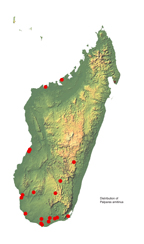Palpares amitinus (Kolbe, 1906)
DIAGNOSIS |
||
TYPE DEPOSITORY |
||
TYPE LOCALITY Madagascar: Tulear, Voelzkow (syntype male and female). |
||
GEOGRAPHICAL DISTRIBUTION This species is found throughout the southern quarter of the country and along the west coast. |
||
TEMPORAL DISTRIBUTION It can be found in the adult stage during any month of the year, although peak emergence appears to be in December. |
||
ELEVATION 9 to 825 m. |
||
REMARKS There is a type specimen of Palpares amitinus fraseri Auber from Fort Dauphin in the Paris Museum. This specimen is similar to typical Palpares amitinus, except that the middle band in the hind wing is discontinuous. This is probably more of a genetic form rather than a subspecies. Palpares decaryi Navas, 1924 was described for what appears to be a specimen of P. amitinus without the connecting hind wing bands. Fraser (1951b) did not include this species in his key to Madagascar species of Myrmeleontidae. |

